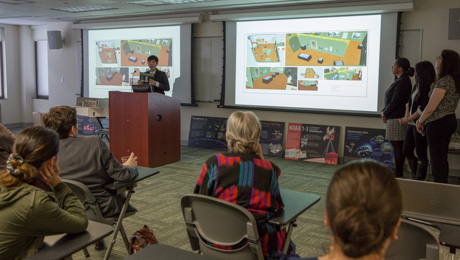By Greg Varner
Once upon a time, museums may have seemed like stuffy places, but today they are caught up in the broader transformations stirring society and culture. And it’s only natural that this story is told in the Museum Studies program of the Corcoran School of the Arts and Design, housed in GW’s Columbian College of Arts and Sciences.
“Museums, like so many other industries, are in this pretty significant moment of transformation,” according to Suse Anderson, an assistant professor in the program, “and it’s coming from several places.”
Part of what’s driving change in the field is the coronavirus pandemic, said Anderson, a specialist in the connections of museums and technology.
“COVID forced museums to think about the visitor experience and what people get from coming into the museum,” Anderson said.
Visual digitization of objects makes it possible for the public to enjoy a museum’s collection remotely, allowing for virtual visits and affording greater access to many works that have been hidden away in storage.
“Digitization enables us to open those crowded storage areas up,” Anderson said, “and if we can put them online, it makes those objects newly useful, reconnects them to culture and arguably helps us justify why we have museum collections in the first place. Because if no one knows or can use a collection, then what’s the purpose of it?”
But increased access can invite greater scrutiny, and the museum field is undergoing a bigger shift in the understanding of who should have the authority to make choices about displaying cultural heritage objects created by Indigenous peoples and other source communities. There is a growing willingness to confront the reality that many significant historical objects held by museums were acquired by means now widely viewed as illegitimate.
The Smithsonian Institution recently announced that it would be repatriating the majority of its famous bronzes of Benin, acquired in raids by British troops in 1897. Other museums in the United States and abroad, including the Metropolitan Museum of Art in New York, have returned Benin bronzes to their homeland.
For many people, Anderson said, some items in museum collections are living or sacred objects even though they may have been in the museum for a hundred years or more. Decisions about whether to digitize or display such works are coming under greater scrutiny.
“I think museum collections, to the extent that they can, should be as open as possible,” Anderson said, “because that does make them more vital. It helps us discover things that have been undiscovered and helps us make new kinds of knowledge. But museums should not be the only ones involved in those decisions, particularly when it comes to contested objects.”
The museum world’s new focus on ethics and values extends to other racial and gender issues, she added. Many museums are still primarily holding works by white male artists. Progressive museum practice calls for professional consideration of transgender inclusion, decolonization and other potentially charged topics.
“Not only do students need practical skills, but they need a deeper way of engaging with this complexity,” Anderson said.
War, theft, destruction and trafficking of objects add additional layers to many of these considerations. On their face, they are arguments in favor of digitization.
“Unfortunately, it would not surprise me if in coming years there’s increased trafficking around objects in or from Ukraine,” Anderson said. “Digitization can be helpful because we can have a record that can make a significant difference for legal cases.”
But digital heritage itself is vulnerable, she added. There have been some efforts to help ensure that Ukraine’s digital heritage is backed up and supported in different locations.
Digitizing objects can also be helpful in reconstructing heritage sites and objects that have been destroyed, according to Tashia Dare, who taught a course on Museums and Cultural Property last year.
“We see such efforts in Syria, for example,” Dare said. “3D printed models have been created as a means of ‘restoring’ heritage lost, which allows current and future generations to continue engaging with that heritage in some way.” She added that cultural objects can be used to bring people together as well as divide them.
“For the last few decades there has been more of a push to protect cultural heritage,” Dare said. “Being able to access and participate in one’s culture and to preserve it for one’s own generation and for future generations is a human rights issue. There are more people in the museum world talking in those terms, seeing this connection between cultural heritage and human rights.”
This focus on rights is part of the larger story that Anderson, Dare and other professionals are telling about the museum studies field.
“Museums are increasingly looking toward models of stewardship and shared authority,” Anderson said, “rather than ownership.”



